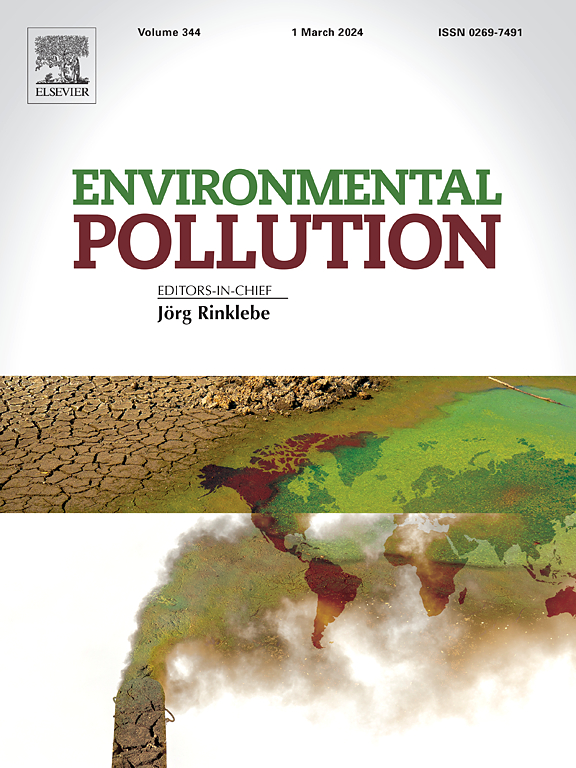Adverse associations of pre-pregnancy exposure to PM2.5 and its components with fetal growth alleviated by residential greenness: a prospective cohort study
IF 7.6
2区 环境科学与生态学
Q1 ENVIRONMENTAL SCIENCES
引用次数: 0
Abstract
Maternal exposure to fine particulate matter (PM2.5) and residential greenness both influence fetal growth. No previous studies have examined their sex-specific and interaction effects. We aim to evaluate the sex-specific effects in these associations and exposure interactions. This study involved 1,275 mother–child pairs enrolled in the Ma'anshan birth cohort in China. Pre-pregnancy exposure to PM2.5 and its components was assessed using a spatiotemporal model based on maternal addresses, while residential greenness was estimated through the normalized difference vegetation index (NDVI) based on satellite data. Fetal parameters—including biparietal diameter (BPD), head circumference (HC), abdominal circumference (AC), femur length (FL), and estimated fetal weight (EFW)—were measured during pregnancy via ultrasound. To examine associations between these exposures and both continuous and categorical outcomes, generalized estimating equations (GEE) and generalized linear regression were applied. Subgroup analyses were conducted to evaluate sex-specific effects. Pre-pregnancy exposure to PM2.5, OM, BC, SO42−, NH4+, and NO3− was correlated with decreased Z-scores of fetal parameters (BPD, FL, EFW, AC) during the second trimester, particularly in male fetuses. In the third trimester, we found that the Z-scores of AC (0.081, 95% CI: 0.001, 0.160) and EFW (0.097, 95% CI: 0.008, 0.185) increased with each interquartile range (IQR) increase in residential greenness. We observed the effect modification of PM2.5 and its components on the relationship between residential greenness and fetal growth in utero. Residential greenness can mitigate the adverse effects of PM2.5 and its components prior to pregnancy on fetal growth. Our findings suggest that increased residential greenness during pregnancy preparation may help alleviate air pollution's detrimental effects on fetal growth.


怀孕前暴露于PM2.5及其成分与胎儿生长的不良关联可通过住宅绿化缓解:一项前瞻性队列研究
母亲暴露于细颗粒物(PM2.5)和住宅绿化都会影响胎儿的生长。此前没有研究考察过它们的性别特异性和相互作用效应。我们的目的是评估这些关联和暴露相互作用中的性别特异性影响。本研究涉及中国马鞍山出生队列的1275对母子。采用基于孕产妇地址的时空模型评估孕前PM2.5暴露及其组分,采用基于卫星数据的归一化植被指数(NDVI)估算住宅绿化度。胎儿参数-包括双顶径(BPD),头围(HC),腹围(AC),股骨长度(FL),估计胎儿体重(EFW) -在怀孕期间通过超声测量。为了检查这些暴露与连续和分类结果之间的关系,应用了广义估计方程(GEE)和广义线性回归。进行亚组分析以评估性别特异性效应。孕前暴露于PM2.5、OM、BC、SO42-、NH4+和NO3-与妊娠中期胎儿参数(BPD、FL、EFW、AC)的z分数下降相关,尤其是男性胎儿。在妊娠晚期,我们发现AC (0.081, 95% CI: 0.001-0.160)和EFW (0.097, 95% CI: 0.008-0.185)的z分数随居住绿色度的每四分位数范围(IQR)的增加而增加。我们观察了PM2.5及其成分对住宅绿化与子宫内胎儿生长关系的影响变化。住宅绿化可以减轻孕前PM2.5及其成分对胎儿生长的不利影响。我们的研究结果表明,在怀孕准备期间增加住宅绿化可能有助于减轻空气污染对胎儿生长的有害影响。
本文章由计算机程序翻译,如有差异,请以英文原文为准。
求助全文
约1分钟内获得全文
求助全文
来源期刊

Environmental Pollution
环境科学-环境科学
CiteScore
16.00
自引率
6.70%
发文量
2082
审稿时长
2.9 months
期刊介绍:
Environmental Pollution is an international peer-reviewed journal that publishes high-quality research papers and review articles covering all aspects of environmental pollution and its impacts on ecosystems and human health.
Subject areas include, but are not limited to:
• Sources and occurrences of pollutants that are clearly defined and measured in environmental compartments, food and food-related items, and human bodies;
• Interlinks between contaminant exposure and biological, ecological, and human health effects, including those of climate change;
• Contaminants of emerging concerns (including but not limited to antibiotic resistant microorganisms or genes, microplastics/nanoplastics, electronic wastes, light, and noise) and/or their biological, ecological, or human health effects;
• Laboratory and field studies on the remediation/mitigation of environmental pollution via new techniques and with clear links to biological, ecological, or human health effects;
• Modeling of pollution processes, patterns, or trends that is of clear environmental and/or human health interest;
• New techniques that measure and examine environmental occurrences, transport, behavior, and effects of pollutants within the environment or the laboratory, provided that they can be clearly used to address problems within regional or global environmental compartments.
 求助内容:
求助内容: 应助结果提醒方式:
应助结果提醒方式:


